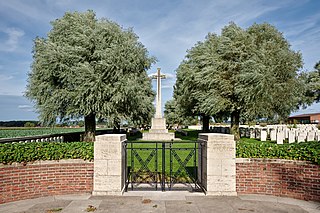
Railway Dugouts Burial Ground (Transport Farm) is a Commonwealth War Graves Commission (CWGC) burial ground for the dead of the First World War located in the Ypres Salient on the Western Front.

The Duke of Cornwall's Light Infantry (DCLI) was a light infantry regiment of the British Army in existence from 1881 to 1959.

Ypres Town Cemetery and Extension is a Commonwealth War Graves Commission burial ground for the dead of the First World War located in Ypres, Belgium, on the Western Front.

Ridge Wood Military Cemetery is a Commonwealth War Graves Commission (CWGC) burial ground for the dead of British Commonwealth soldiers who fought in the First World War. The cemetery is in Voormezeele, West Flanders, Belgium, in the Ypres Salient of the Western Front.

Blauwepoort Farm is a Commonwealth War Graves Commission burial ground for the dead of the First World War located near Ypres in Belgium on the Western Front.

Brandhoek New Military Cemetery Number 3 is a Commonwealth War Graves Commission burial ground for the dead of the First World War located near Ypres in Belgium on the Western Front.

Buffs Road Cemetery is a Commonwealth War Graves Commission burial ground for the dead of the First World War located near Ypres in Belgium on the Western Front.

La Belle Alliance Cemetery is a Commonwealth War Graves Commission burial ground for the dead of the First World War located near Ypres (Ieper) in Belgium on the Western Front.

New Irish Farm Cemetery is a Commonwealth War Graves Commission burial ground for the dead of the First World War located near Ypres in Belgium on the Western Front.

Oxford Road Cemetery is a Commonwealth War Graves Commission burial ground for the dead of the First World War located near Ypres (Ieper) in Belgium on the Western Front.

PerthCemetery is a Commonwealth War Graves Commission burial ground for the dead of the First World War located near Ypres (Ieper) in Belgium on the Western Front.

Woods Cemetery is a Commonwealth War Graves Commission burial ground for the dead of the First World War located near The Bluff south of Ypres (Ieper) in Belgium on the Western Front.

Hedge Row Trench Cemetery is a Commonwealth War Graves Commission burial ground for the dead of the First World War located near The Bluff south of Ypres (Ieper) in Belgium on the Western Front.

Zillebeke Churchyard Commonwealth War Graves Commission Cemetery forms part of the village churchyard located around the Catholic parish church of Zillebeke in Belgium.

The St Symphorien Military Cemetery is a First World War Commonwealth War Graves Commission burial ground in Saint-Symphorien, Belgium. It contains the graves of 284 German and 229 Commonwealth soldiers, principally those killed during the Battle of Mons. The cemetery was established by the German Army on land donated by Jean Houzeau de Lehaie. It was initially designed as a woodland cemetery before being redesigned by William Harrison Cowlishaw after the Imperial War Graves Commission took over maintenance of the cemetery after the war.
Major General David Noel Hugh Tyacke CB OBE was a senior British Army officer. His last post was as General Officer Commanding the Singapore District and he had previously been the last commanding officer of 1st Battalion, Duke of Cornwall's Light Infantry (DCLI) prior to amalgamation into the Somerset and Cornwall Light Infantry.

Essex Farm Cemetery is a World War I, Commonwealth War Graves Commission burial ground within the John McCrae Memorial Site near Ypres, Belgium. There are 1,204 dead commemorated, of which 104 are unidentified. The cemetery was designed by Sir Reginald Blomfield and has an area of 6,032 square metres (64,930 sq ft).

Buttes New British Cemetery is a Commonwealth War Graves Commission burial ground for the dead of the First World War located in the Ypres Salient in Belgium on the Western Front.

The Actions of the Bluff were local operations in 1916 carried out in Flanders during the First World War by the German 4th Army and the British Second Army. The Bluff is a mound near St Eloi, south-east of Ypres in Belgium, created from a spoil heap made during the digging of the Ypres–Comines Canal before the war. From 14 to 15 February and on 2 March 1916, the Germans and the British fought for control of the Bluff, the Germans capturing the mound and defeating counter-attacks only for the British to recapture it and a stretch of the German front line, after pausing to prepare a set-piece attack.



















